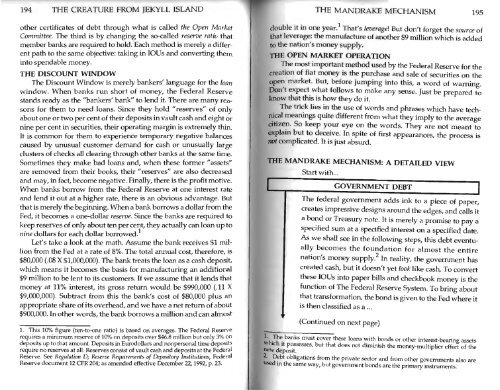Create successful ePaper yourself
Turn your PDF publications into a flip-book with our unique Google optimized e-Paper software.
194 THE CREATURE FROM JEKYLL ISLAND<br />
other certificates of debt through what is called the Open Market<br />
Committee. The third is by changing the so-called reserve ratio that<br />
member banks are required to hold. Each method is merely a different<br />
path to the same objective: taking in IOUs and converting them<br />
into spendable money.<br />
THE DISCOUNT WINDOW<br />
The Discount Window is merely bankers' language for the loan<br />
window. When banks run short of money, the Federal Reserve<br />
stands ready as the "bankers' bank" to lend it. There are many reasons<br />
for them to need loans. Since they hold "reserves" of only<br />
about one or two per cent of their deposits in vault cash and eight or<br />
nine per cent in securities, their operating margin is extremely thin.<br />
It is common for them to experience temporary negative balances<br />
caused by unusual customer demand for cash or unusually large<br />
clusters of checks all clearing through other banks at the same time.<br />
Sometimes they make bad loans and, when these former "assets"<br />
are removed from their books, their "reserves" are also decreased<br />
and may, in fact, become negative. Finally, there is the profit motive.<br />
When banks borrow from the Federal Reserve at one interest rate<br />
and lend it out at a higher rate, there is an obvious advantage. But<br />
that is merely the beginning. When a bank borrows a dollar from the<br />
Fed, it becomes a one-dollar reserve. Since the banks are required to<br />
keep reserves of only about ten per cent, they actually can loan up to<br />
nine dollars for each dollar borrowed.<br />
Let's take a look at the math. Assume the bank receives $1 million<br />
from the Fed at a rate of 8%. The total annual cost, therefore, is<br />
$80,000 (.08 X $1,000,000). The bank treats the loan as a cash deposit,<br />
which means it becomes the basis for manufacturing an additional<br />
$9 million to be lent to its customers. If we assume that it lends that<br />
money at 11% interest, its gross return would be $990,000 (.11 X<br />
$9,000,000). Subtract from this the bank's cost of $80,000 plus an<br />
appropriate share of its overhead, and we have a net return of about<br />
$900,000. In other words, the bank borrows a million and can almost<br />
1. This 10% figure (ten-to-one ratio) is based on averages. The Federal Reserve<br />
requires a minimum reserve of 10% on deposits over $46.8 million but only 3% on<br />
deposits up to that amount. Deposits in Eurodollars and nonpersonal time deposits<br />
require no reserves at all. Reserves consist of vault cash and deposits at the Federal<br />
Reserve. See Regulation D; Reserve Requirements of Depositor]/ Institutions, Federal<br />
Reserve document 12 CFR 204; as amended effective December 22, 1992, p. 23.<br />
THE MANDRAKE MECHANISM 195<br />
double it in one year. 1<br />
That's leverage] But don't forget the source of<br />
that leverage: the manufacture of another $9 million which is added<br />
to the nation's money supply.<br />
THE OPEN MARKET OPERATION<br />
The most important method used by the Federal Reserve for the<br />
creation of fiat money is the purchase and sale of securities on the<br />
open market. But, before jumping into this, a word of warning.<br />
Don't expect what follows to make any sense. Just be prepared to<br />
know that this is how they do it.<br />
The trick lies in the use of words and phrases which have technical<br />
meanings quite different from what they imply to the average<br />
citizen. So keep your eye on the words. They are not meant to<br />
explain but to deceive. In spite of first appearances, the process is<br />
not complicated. It is just absurd.<br />
THE MANDRAKE MECHANISM: A DETAILED VIEW<br />
Start with...<br />
GOVERNMENT DEBT<br />
The federal government adds ink to a piece of paper,<br />
creates impressive designs around the edges, and calls it<br />
a bond or Treasury note. It is merely a promise to pay a<br />
specified sum at a specified interest on a specified date.<br />
As we shall see in the following steps, this debt eventually<br />
becomes the foundation for almost the entire<br />
nation's money supply. 2 In reality, the government has<br />
created cash, but it doesn't yet look like cash. To convert<br />
these IOUs into paper bills and checkbook money is the<br />
function of The Federal Reserve System. To bring about<br />
that transformation, the bond is given to the Fed where it<br />
is then classified as a ...<br />
(Continued on next page)<br />
I lite banks must cover these loans with bonds or other interest-bearing assets<br />
wnich it possesses, but that does not diminish the money-multiplier<br />
new effect of the<br />
deposit.<br />
r<br />
I Debt obligations from the private sector and from other governments also are<br />
used in the same way, but government bonds are the primary instruments.


